E. Kristin Anderson's Blog, page 25
April 7, 2014
National Poetry Month: Guest Post from Burleigh Mutén: Writing Miss Emily
Typical townie, I didn’t visit the Emily Dickinson Museum when it opened ten years ago even though I’m a poet.
Typical teacher, I went when I decided to add Dickinson to the curriculum for the Community Study I teach every fall. All children in Amherst need to know about the most famous resident of our little town, but would the Dickinson Homestead be appropriate for five year olds? Would the guides in the big yellow house be engaging and patient with young children?

The Dickinson Homestead.
Yes, I discovered, even very young children could enjoy the museum. And as the tour continued that fateful day, I discovered something else — about myself. I began to be fascinated by Emily Dickinson. My curiosity quickly became voracious, demanding much more information than I needed in order to teach Dickinson to kindergartners.
A book entitled EMILY DICKINSON: FRIEND & NEIGHBOR (written by MacGregor Jenkins, who had lived across Main Street from the Dickinsons when he was a boy) changed the direction of my teaching and ultimately, my writing. Jenkins played with Miss Emily’s niece and nephew and was one of the recipients of the basket of gingerbread that she lowered from her bedroom window.
The Miss Emily that Jenkins described was quite unlike the sober-faced portrait of the poet that we all know. She was not the mysterious recluse either. “She was our laughing goddess of plenty,” he wrote. “She was a joyous person.”
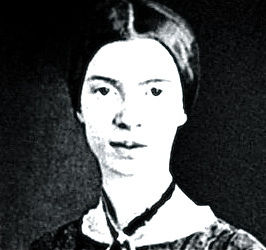
Portrait of Emily Dickinson at 16.
The sort of person every child should know, I thought. The sort of adult who listens and remembers what matters to you. A playful and irreverent friend whose love of nature and word play matches your own. Children need to know what a treasured friend Dickinson was to the children in her life, I decided.
Typical writer, I set about writing a children’s book portraying this little known side of Dickinson, the devoted, caring adult in the lives of the children who knew her?
I returned to the museum, this time visiting the house next door, The Evergreens, where Dickinson’s brother Austin lived with his family.

The Evergreens.
There, in the upstairs hallway, I read a small sign describing the children’s play after the circus had been in town. There, in that long narrow passage, they’d pretended it was a train car, carrying acrobats and exotic animals. The arc of a story hissed through my imagination like a locomotive screeching into a small town station.
Miss Emily would invite her young friends to sneak out at night to meet the circus train as it arrived in town. The station is the same today as it was then, so I walked from the Evergreens down the street to the station, imagining a group of exuberant children led by the adult they trusted to lead them into adventure.
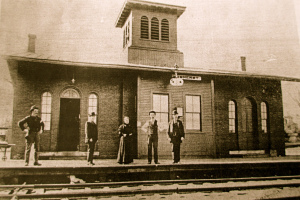
Amherst Train Station.
Researching American circus history was almost as much fun as researching Miss Emily. I discovered that the circus that entertained Amherst in the late 1880s was Van Amburgh and Company’s Great Golden Menagerie and Frost’s Roman Circus and Royal Colliseum. What provocative poetry, just in its name!
One of the most dramatic acts was the Lion King, an act that Isaac Van Amburgh had created and performed both in the US and Europe. Leading a lion into the ring, Van Amburgh pried open its jaws and placed his head in the beast’s mouth.
[image error]
Issac Van Amburgh, “The Lion King.”
Not long into the writing process, I remembered my own poetic voice. I had written free verse as a teenager when I started writing, and I’d continued to write poetry through the years – but that was my private voice. I’m not sure whether it was all the Dickinson poems I read at the time or whether it was her bold authenticity that nudged me into claiming my own voice as a poet.
What fun I had with lineation, still one of my favorite aspects of writing free verse (and the computer makes it so easy). I wasn’t sure I could pull off writing a note from Dickinson to the children in words that were not hers, but what a joyful task to study the notes she did write to them, and attempt to keep to her form.
And the playful plot! Miss Emily proposes that the children join her in the Dickinson’s barn at midnight. Once gathered in the dark of night, she gives them all stage names for their escapade. These Amherst Gypsies set out to greet the train! Halfway to their destination, they rest beneath an old beech tree with branches that droop down to the ground, creating a cave-like effect.
And now, three excited children are waiting for the train to arrive. I remember feeling as if I’d reached a major goal, getting the story that far. And what now? What would Miss Emily do to direct the plot in a new direction? What would I do, I asked myself, if I were in the same enthralling situation? I knew immediately what I’d do: I’d tell a story to help the children harness their excitement, a story to enhance their joy.
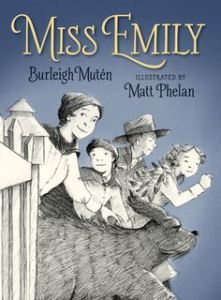
Candlewick, March 2014.
This is when the writer surprises herself. As a reader, I have always enjoyed the literary device of a story within a story, but I hadn’t set out to write one. It happened organically as I entered the characters and plot or should I say as they entered me?
MISS EMILY couldn’t tell any old story. It would have to relate to the arc of the larger story. It would have to entertain and reflect the story around it in a meaningful way.
So I wrote a little story about a circus horse who asked his trainer, Mr. John Bill Wrinkles, to help him fulfill his dream. And I named the horse Edward after Emily’s father, the somber Squire Edward Dickinson of Amherst, thinking this might have been something she’d do.
Typical writer, I saw something fresh and important for youngsters to know as they approach an iconic poet: Emily Dickinson loved children. Typical writer, I saw an opportunity to write in verse, found my voice, and as the saying goes, had the time of my life.
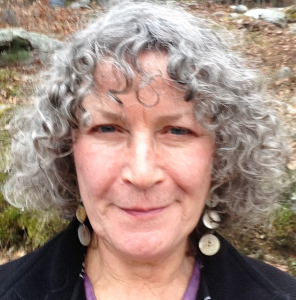
Burleigh Mutén.
Burleigh Mutén is the author of five children’s books. She is a kindergarten teacher in Amherst, MA and a member of the Emily Dickinson International Society. She has led writing workshops for older children throughout New England, including workshops focused on Dickinson and her work in which young authors are given the opportunity to write in the houses of the Emily Dickinson Museum.





April 6, 2014
National Poetry Month: Guest Post from Lorna Crozier: Coming Around to Rhyme
I’ve been publishing poetry books for over forty years, but LOTS OF KISSES is my first book for kids. I’d never thought of writing one, and I wouldn’t have attempted to do so if Andrew, the publisher of Orca Books, hadn’t approached me after one of my readings and suggested that I’d be good at it. My usual response to a new challenge is to feel inadequate. I told him, “No, I don’t think so,” then went home and a few days later couldn’t get rid of the rhymes that started to roll off my tongue.
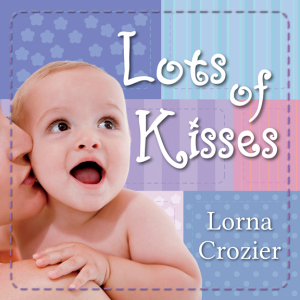
Orca Books.
Like most contemporary poets, I’ve avoided rhymes at the end of lines all of my writing life. I value music in poems more anything else, but I’ve worked hard to thread through the sound repetitions in more subtle ways. After Andrew’s prompt, when I allowed myself to roll around in words like nose and toes and elbows, I felt as if I were breaking some kind of taboo. Yet I haven’t had so much fun since my days as a high school cheerleader (yes, I admit it) when I lay awake in bed composing yells for the squad and couldn’t wait to get to practice to show my friends.
All that grade-ten fall, I was cruising along, happy with my new creative role until one evening during half-time at a basketball game. The captain, whom we all had a crush on, walked across they gym floor and said he’d kill us if we did that cheer again. He and the team wanted the old traditional yells; the novelty of the new ones—my rhyme-rich creations set to contemporary music like the Beatles’—embarrassed them. Maybe that response is what dampened my enthusiasm for the mouth-watering, childlike pleasure of searching for word twins that are frisky and lighthearted and full of beans.
Now I’m thrilled to be rhyming again. Whenever I feel hesitant, I think of my grandchildren and their delight in waiting for what will follow and match a word like cat in one of the many page-worn books that are part of their library. For them and for me, the vowels that snap together like magnets are a form of delicious play. In LOTS OF KISSES, my first board book, I hope kids will feel each rhyming pair as a big smack on the cheek that makes them feel loved by words and that makes them eager to come back for more.
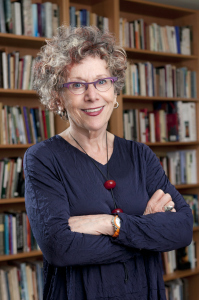
Lorna Crozier. (Photo by Photographic Services, University of Victoria.)
Lorna Crozier has authored fifteen books of poetry and received many awards and nominations, including a 1992 Governor General’s Award, the Canadian Authors Association Poetry Award, the National Magazine Award (Gold Medal) and first prize in the National CBC Literary Competition. She has read her poetry on every continent except Antarctica, and in 2005 Crozier recited a poem for Queen Elizabeth II as part of Saskatchewan’s centennial celebration. For more information, visit www.lornacrozier.ca.





April 5, 2014
National Poetry Month: Guest Post from Guadalupe Garcia McCall: A New Chapter in My Writing Life — Poetry for Younger Readers and Their Teachers
I’ve been in love with writing poetry for a “younger audience” for a few years now. The inspiring Sylvia Vardel and the energetic, effervescent Janet Wong contacted me soon after the release of my debut novel, UNDER THE MESQUITE (Lee & Low Books, 2011). They were embarking on a new project, THE POETRY FRIDAY ANTHOLOGY (PFA), a collection for teachers, a resource which would inspire educators to share a great poem every Friday with their students.
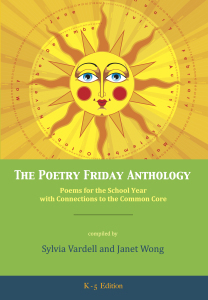
Pomelo Books, August 2012.
Their formula was simple: give them poetry to share and love. So when asked me if I had anything I’d like to submit, I sent them, “Bailes,” “Doña Pepita,” and “The Bully” three poems that didn’t quite fit and were eventually cut from UNDER THE MESQUITE. For the second installment, POETRY FRIDAY ANTHOLOGY FOR MIDDLE SCHOOL, I sent them “The Cafe” and “The Boy,” two more defunct poems from UNDER THE MESQUITE. Up to that point, it had been a pretty pleasant, painless experience. I submitted poems I loved, and these ladies put them in their anthologies. It seemed a simple enough formula: Piece of Cake, I thought!
Well, the first two PFA’s were so successful and so beloved, that these great ladies came up with a third installment entitled POETRY FRIDAY ANTHOLOGY FOR SCIENCE (STEM). So when they asked me if I would submit, I jumped in with a resounding, “OF COURSE!”
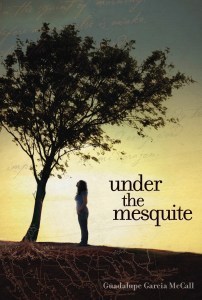
Lee and Low Books, September 2011.
However, when they sent me the list of topics, I panicked. Nature is one of my favorite subjects, but to marry it to Science and Technology seemed like something that was way off base for me. My mind just couldn’t wrap itself around it: I write from life experience, it kept saying. I write personal narratives. I write free verse poems. I write because I absolutely have to, because it’s part of who I am at my core— not part of the core curriculum! This was something totally new for me, and I began to doubt I could do it justice. I have to admit, at that point, I started hyperventilating. Even as I told myself to just focus on the topic by picking something I remembered from my own childhood years, I was stressing!
Just looking at that looooong list of science topics gave me cold sweats. My vision blurred, my pulse literally ached inside my veins, and I had to take a nap just to recover from the pressure of trying to write for a younger audience from a list of words that were vaguely, if not painfully, familiar. I got up from my nap, drank a cold glass of water, and looked at the list again. Then I remembered something. Science was one of my favorite subjects in elementary school. Memories started to creep into my mind: my gorgeous leaf project, the cicada I brought to school in a matchbox, and the drawing of the water cycle which hung in Mr. Hernandez classroom all year because he loved it so much. That’s when I adapted a new mantra, “I can do this. I can do this. I can do this.”
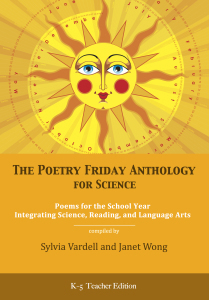
Pomelo Books, February 2014.
As I started circling topics I might be able to “research,” other memories came back to taunt me: College Science Classes. Botany. Biology. Clipboards. Lab Tests… and I started to sweat again. But then, miraculously, one more vision came to me. Blue Book Essays! But that vision didn’t make me sweat. On the contrary, that vision made me laugh. I remembered that my science professor gave me a “D” and wrote, “This is science, Ms. Garcia, not FICTION!” on one of my favorite Blue Book essays (I had explained how the mitochondria “lives” by personifying it through every stage of its life cycle). Needless to say, it wasn’t at all what he was looking for. Although I still think he should have given me a “A” for creativity.
Somehow that memory was a revelation, and I realized that YES, I absolutely could tackle writing something fun and new and innovative for teachers who are trying to teach science. So I took my circled topics and I went into my little science poetry lab and came up with not one by three poems I loved, poems I wished I had read as a child, poems that would have brought science to life for me. Then I did something I often do when I love a set of poems. I translated them into Spanish, just for fun! I submitted my science poems, “Oh, Water, My Friend” (“Ay, Agua, My Amiga”) “Cicada” (“Chicharra”), and “Sun-Kissed” (“Besado Por El Sol”) to Sylvia and Janet, and, because these ladies are so fantastic, they put both the English and Spanish versions in the PFA for Science, and the rest is history.
I did it. I wrote for young readers! I wrote about the wonder of discovery, and nature, and everything I love about science. I wrote for fun!
This is my favorite poem from the PFA for Science:
“Cicada”
I dug my toes into the dirt
and felt a tickle at my heel.
A pretty nymph had crept up there
and made me jump and squeal.
“What do you want from me?”
I asked the young cicada.
“I need to climb up on that tree,
To feel the sun, to have some fun,
to shed my skin, and rest and sing.
I need some time to think,
to shake the daze from all that sleep,
and dust off my brand new wings.”
So I let her climb upon my finger
and placed her gently on the bark
that she may crawl up to the top
and someday soon enjoy the park.
For information on the POETRY FRIDAY ANTHOLOGY and to listen to me reading my poems from these collections you can visit the Pomelo Books Website:
It’s quite an adventurous place. There’s poetry movies to watch, audio recordings to listen to, and even printable poems to download and share. Enjoy!
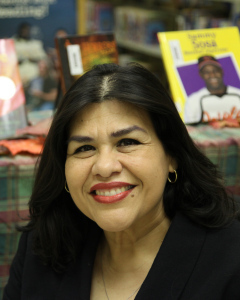
Guadalupe Garcia McCall.
Guadalupe Garcia McCall is the author of UNDER THE MESQUITE (Lee & Low Books), a novel in verse. UNDER THE MESQUITE received the prestigious Pura Belpre Author Award, was a William C. Morris Finalist and received the Ellen Hopkins Promising Poet Award, the Tomas Rivera Children’s Book Award, and was included in Kirkus Reviews’ Best Teen Books of 2011 among many other honors and accolades. Her second novel, SUMMER OF THE MARIPOSAS (Tu Books, an imprint of Lee & Low Books), won a Westchester Young Adult Fiction Award, was an Andre Norton Award for Young Adult Science Fiction and Fantasy Finalist, and was included in the 2013 Amelia Bloomer Project List, theTexas Lone Star Reading List, and the 2012 School Library Journal’s Best Books of the Year. Her poems for adults have appeared in more than twenty literary journals across the country and abroad, and her poems for children are included in THE POETRY FRIDAY ANTHOLOGY, THE POETRY FRIDAY ANTHOLOGY FOR MIDDLE SCHOOL, and THE POETRY FRIDAY ANTHOLOGY FOR SCIENCE. Ms. Garcia McCall was born in Piedras Negras, Coahuila, Mexico. She immigrated with her family to the United States when she was six years old and grew up in Eagle Pass, Texas (the setting of both her novels and most of her poems). She is currently a high school English teacher in the San Antonio area and lives in Somerset with her husband, Jim, 2 dogs (Baxter and Blanca), 1 cat (Luna), and her two (of three) college age sons, Steven and Jason.





April 4, 2014
National Poetry Month: Guest Post from Victoria Allenby: The Case for Nursery Rhymes
Folks, I have a confession to make: I’m standing on a soapbox. Right now. But I’m not after your wallet and I don’t want your vote, so maybe you’ll find a moment to listen to my National Poetry Month plea:
The Case for Nursery Rhymes
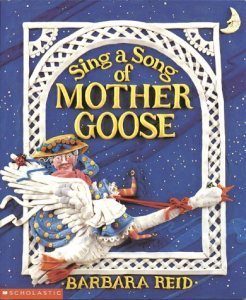
Scholastic Trade, April 1989.
When I was three, I used to sneak into my sister’s bedroom, plop down on the floor in front of her bookcase, and pull out her book of Mother Goose rhymes. She had dozens of books, all equally—tantalizingly—forbidden to me*, but I only remember stealing the nursery rhymes. I would gaze at the pictures and trace my finger along the magical black squiggles and dream of the day when they would turn into words. I couldn’t wait for that miracle to happen.
Why steal the nursery rhymes? Probably because I already knew them. They were stuck in my mind with their bouncing rhythms, their sing-songy rhymes, and their deliciously exotic words—nowhere else had I encountered anyone with a “tuffet” or a “cockleshell”. These strange, old street chants, skipping rhymes, and tavern songs had become my most alluring gateway to literacy, as they have for so many others since being adopted by the nursery.
I feel sometimes that these rhymes are out of fashion these days. Maybe some people are turned off when they discover that most weren’t written for children at all. Possibly they’re just seen as outdated. There is also a wealth of wonderful poetry from recent writers that I would never dream of discounting—I’m a picture book author myself, after all. But for me, the journey there started with my sister’s book of old-fashioned nursery rhymes.
Well, I learned to read, grew up, and went to university. There I studied scansion and used words like “dactylic hexameter” and “spondee” and “phoneme.” Today I do the same thing, but I get to call it “writing rhymes for children.” It’s sophisticated stuff—just look at the flawless progression from internal rhyme into alliteration in the line, “Hickory, dickory, dock.” Or think about the early exposure kids get to procedural text with “Pat-a-Cake.” And who can forget the counting practice provided by “One, Two, Buckle My Shoe”?
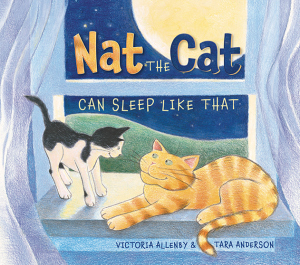
Pajama Press, March 2014.
So why nursery rhymes? Because they are so very, very important. Their repetition, rhyme, and rhythm are gateways to language for young minds seeking patterns to understand the world. They exercise the memory, the imagination, the tongue. They teach vocabulary, history, and music. They help kids learn to read by teaching them to recognize rhyming words (that’s learned, by the way. Your ear wasn’t born with it). Maybe it’s obvious by now that studying these things is a super-nerdy hobby of mine. I’ll rein myself in now and spare you the more technical details. Instead I’ll leave you with one more anecdote. One that isn’t about the nitty-gritty details of consonants and rhymes:
It is night, many years ago, and I am pressed up against the glass of my grandmother’s porch window. The country sky stretches wide above me and I think to myself,
Twinkle, twinkle, little star—
How I wonder what you are.
How I wonder…
How I wonder…
How I wonder…
And the song did make me wonder. What were those stars up there? It marked the start of a lifetime habit of wondering about the world and the universe. It filled me with wonder. And I haven’t been emptied of it yet.
Happy poetry month, everybody. I hope you get the chance to celebrate with the littlest readers and listeners in your lives. I hope you get to spread the wonder.
*Please note that when I say “forbidden,” I mean by the rules of my five-year-old overlord sister. My parents would never keep a child away from books.
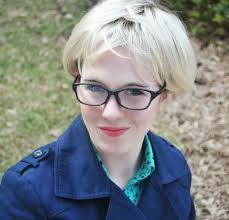
Victoria Allenby.
Victoria Allenby dictated her first picture book to her mother at the age of two. Since then she has learned to write things down herself, and today makes a living as a freelance writer and editor. She lives in Toronto with Cole, a cat who thinks he is much more interesting than laptops and books.





April 3, 2014
National Poetry Month: Guest Post from Naomi Shihab Nye: On Language-Energy
American School of Bombay, February 2014
Jackhammers pounding, a whole block torn up. Lively Kohinoor neighborhood in some dramatically mixed condition of process and decay. Ancient India of fluttering flags and open cook shops right down that skinny alleyway, mixing with giant apartment complexes where many teachers live, and a sweetly designed new hotel with ELITE in its name.
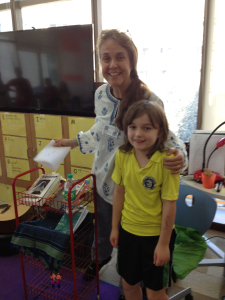
Naomi and Calum.
Are the workers putting in new pipes? Good luck to them. Every element of infrastructure for this smoky-smelling 20.5 million mega-city boggles the brain. I lie awake thinking – how could anything work at all? How does water emerge from a faucet? Electricity, seriously? I am not surprised at all when the wireless connection doesn’t work on the 5th floor. How could it? We actually crossed a street yesterday and are still alive?
In such a mood I passed through Security into yet another inspiring school in this crazy crowded world, rode an elevator, entered the third grade and was swept away by Poetry Joy! Words surrounding us on giant papers! Definitions, drawings, wide windows…an instant sense of language-energy on the air.
Radiant teacher Nancy, from Michigan, loves and writes poetry too. All the teachers and their beautiful librarian Heeru seem like creative wizards to me, the lucky guest who’s been writing down favorite signs since I arrived in India – PLEASE DO NOT THROW FLOWERS INTO THE SEA, EVEN GOD WOULD NOT APPROVE or DON’T EAT HEAVY MEALS AFTER 5 P.M. or FIGHT THE BITE (then a drawing of an ominous-looking mosquito). One thing for certain: you may travel many places on earth but you will never, never, find better signs than the signs in India.
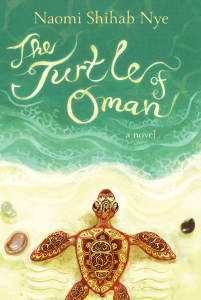
Greenwillow Books, August 2014.
And it has always seemed so easy and natural to talk about poetry in India, this vast land of ancient voices and mixed languages…my first trip to India 30 years ago someone in a library asked how it feels to live in a country (the United States) with “such a short soul.” I remember feeling thunderstruck, then remembered how I often shared a 2,000 year old “family poem” by someone called Vishnavath with my Texas students.
Today as usual I jabber a little poetry talk to get us going – read a few poems, discuss keeping notebooks, ask questions about their notebooks or writing practices – and a boy from New Zealand, Calum, toward the back, pipes up – “It’s as if invisible rubber bands connect me to my notebook and are always pulling me back.” Boing! My brain flips. Thank you, Calum! Excuse me a moment, I have to write that down…later he’ll say something like, “We’re tree trunks and everything around us is our branches, we’re connected to everything…” and again, I must write this on my new Calum page in front of me and I think of this boy’s shining life in the world, his radiant way with words and feel heartened again, so heartened, as anyone who lives in a world of continuously “breaking news” must be when they hear – one true voice.
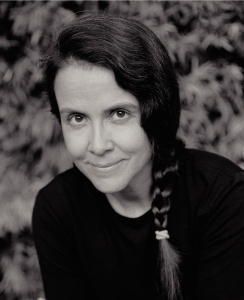
Naomi Shihab Nye. (Photo by Michael Nye.)
Naomi Shihab Nye was named a National Book Award finalist for 19 VARIETIES OF GAZELLE: Poems of the Middle East. The author has been honored with a Lannan Foundation Fellowship, a Guggenheim Fellowship, the Witter Bynner Fellowship from the Library of Congress, the I.B. Lavan Award from the Academy of American Poets, and four Pushcart Prizes, as well as numerous honors for her books for younger readers, including two Jane Addams Children’s Book Awards. She is also the editor of the poetry anthologies IS THIS FOREVER, OR WHAT?: Poems and Paintings from Texas; THE SPACE BETWEEN OUR FOOTSTEPS: Poems & Paintings from the Middle East; SALTING THE OCEAN; WHAT HAVE YOU LOST?; THIS SAME SKY; and TIME YOU LET ME IN; as well as the author of the novels HABIBI, and the upcoming THE TURTLE OF OMAN, the essay collection I’LL ASK YOU THREE TIMES, ARE YOU OKAY?, the short story collection THERE IS NO LONG DISTANT NOW, the picture books BABY RADAR, SITTI’S SECRETS and COME WITH ME, and the poetry collections HONEYBEE and A MAZE ME. She lives in San Antonio, Texas.





April 2, 2014
National Poetry Month: Guest Post from Karma Wilson: The Gateway Drug to Poetry
When I visit school children I ask kids to raise their hands if they like poetry. The response varies, but usually only a few ever do. It’s discouraging on the face of things, but usually by the time I leave when I ask the question again, all the kids raise their hands. You see, the fact of the matter is that most children, and in fact most people, do enjoy poetry…they just haven’t realized it.
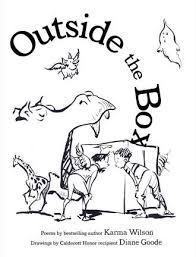
Margaret K. McElderry Books, March 2014.
After I pose that question, I then ask another question. “How many of you like songs on the radio or ipod?” The show of hands SKY ROCKETS, and almost every hand is now proudly waving in the air. This is when I “get” them. “But wait a minute, a bunch of you said you don’t like poetry. Songs with words ARE poems set to music.”
I then add all the other places you may find poems. Video games that incorporate role-play often have poems scattered through the gameplay and quests. Slogans for catchy ads are really just small poems. Rap is poetry. Jump rope chants are poetry. Poetry is everywhere.
Children are scared of poems because they think they are strictly cemented in an adult world—a world of dry lines, words they don’t understand, or content that isn’t aimed to their interests. Getting kids to like poetry is a little like getting a baby switched to solid food—you don’t start them on steak and potatoes. Instead, you give them food more suited to their young palettes and nutritional needs. Kids don’t need to be taught to love poetry; they need to be taught that they probably already do love poetry.
Music is often a child’s first introduction to poetry, even prior to books. Music is heard in the womb, it’s often played in the home, and adults in their life passing the time sing it. Music has a “cool” factor that can help break down a child’s leeriness of poetry. Music is a great tool for teachers, librarians, and parents to use in their literacy arsenal.
So how? Well, a great way is to ask kids to name a few songs they love, and then look up the song and lyrics (sometimes you may have to search for a “clean” version of the song). Now play the song in class (this is the fun part—I encourage you to let them dance, whoop it up, and enjoy the experience.) Then take those lyrics, write them in poetry form, and break it down for them. In my example I’ll use lyrics from a song that used to be very popular, and is kid friendly and catchy, “Fireflies” by Owl City. So here’s a verse from that song:
‘Cause I’d get a thousand hugs
From ten thousand lightning bugs
As they tried to teach me how to dance
A foxtrot above my head
A sock hop beneath my bed
The disco ball is just hanging by a thread
Wow, what a wealth of poetry lessons in ONE VERSE! Yay! What are some topics that could be covered aside from the obvious rhyme: Word play, puns, metaphor, how accents affect rhythm and flow.
Start by reciting the chosen verse without the music. Read it straight-faced, little emphasis on words, just a clean, boring read. Then point out how boring that sounded compared to the verse with music. Explain that poems, like songs, stories, and movies, are best when “performed” not just read. Then “perform” the poem (this doesn’t require you to sing, no worries….).
By perform, I mean recite with emphasis, life, humor, and emotion. For the verse I chose I would do something like this:
‘Cause I’d get a thousand hugs (Emhasis on the word “thousand” and I’d use my arms to hug myself.)
From ten thousand lightning bugs (even MORE emphasis on the words “ten thousand, and I’d use finger play to indicate the “fireflies).
As they tried to teach me how to dance (I’d raise my eyebrows quizzically at the idea of fireflies teaching me how to dance, and do a few impromptu dance moves…)
A foxtrot above my head (I’d look up, as if asking “Where’s the fox?” )
A sock hop beneath my bed (I’d shrug and raise my hands as if asking, “What? Really?)
The disco ball is just hanging by a thread
From there let the discussion role! Kids love breaking down poems, and discussing word choices. They love being asked their opinion. They love feeling that what is important to them is important to YOU as well.
By using songs in your poetry lessons you can make music the “gateway drug” to a life long love of poetry.

Karma Wilson.
Karma Wilson’s picture books include the international bestseller BEAR SNORES ON, BEAR WANTS MORE, BEAR STAYS UP FOR CHRISTMAS, and MORTIMER’S CHRISTMAS MANGER, all illustrated by Jane Chapman; A FROG IN THE BOG, illustrated by Joan Rankin; HILDA MUST BE DANCING and BEAR HUGS, illustrated by Suzanne Watts; and WHO GOES THERE?, illustrated by Anna Currey. She lives with her family in Fortine, Montana. Visit Karmaat KarmaWilson.com.





April 1, 2014
National Poetry Month: Guest Post from Kirsten Smith: How YA Brought Me Back to Poetry
Freshman year of college at Occidental, my roommate Ryan Latimer gave some of my poetry to her English professor, Professor Michael Near. What resulted was probably one of the happiest days of my life, because Professor Near said he liked my poetry.
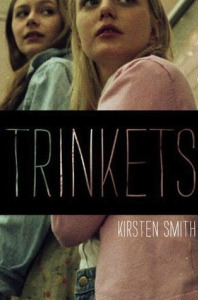
Little, Brown Books for Young Readers, March 2013.
As you writers know, the moment an esteemed professional validates your writing feels like nothing else. Professor Near’s faith in me emboldened me to talk to some of my dorm mates about putting my work into their literary magazine, HOLY COW.
So, in 1989, they decided to publish this poem, which I dug up to share with you here:
“Dream Songs”
I was sailing a boat
smaller than a bottle.
I was waiting for
my father to tell me
what to do.
We began to sink
into the Pacific.
Salt water
washed across my arms.
Now I crack when I bend.
I had found my place in the world: I was a poet! I did readings, submitted hundreds of poems to literary magazines and was sure I’d have a book of poetry published by the time I was 21.
Okay, so that didn’t happen.
But a girl can dream, and I plugged away at my dream. I was accepted into the Breadloaf Writer’s Conference on an emerging writer scholarship (Elisa Schappel, Vendela Vida and Elwood Reid were also in our group); I got invited to stay as a writer-in-residence at the MacDowell Colony; and I also realized I didn’t want to pursue my MFA. Instead I wanted to make a go of my other love: film, where I could potentially make a bit more money as a screenwriter than I could as a poet. I got a job reading scripts at CineTel Films, where I had done a college internship, and was eventually asked by my boss to work full time in screenplay development. After a year and a half at that job, and through her encouragement, I missed writing and decided to quit to write “full-time.” I was having trouble motivating until I met a writing partner and she and I began writing a female action movie together. While it didn’t sell, we clicked and decided to write a teenage movie which became 10 THINGS I HATE ABOUT YOU. Through a twist of lucky fate, the film got made quickly and we began working full-time writing screenplays, some of which never got made (like a girl surfing movie, for which we wrote 42 drafts, no joke) and even one which became a big hit (LEGALLY BLONDE).
I was making a living as a screenwriter, but a tiny piece of me missed being a poet. I thrived in the short-short story form that came with narrative poems, mixing dark and light imagery, tangling up oddball comedy with pathos. I wrote a poem for the end of 10 THINGS I HATE ABOUT YOU, but other than that, my poetry side was dormant.
Then in 2003 I met a book agent called Steven Malk. We talked about my turning my film credits into publishing cache by writing a YA novel. I wasn’t sure exactly what I’d write, but he was kind enough to give me his email. He was dating a girl named Jennifer at the time and I told him I’d written a poem once called “The Jennys,” maybe I should send it to him. Here it is:
“The Jennys”
No one can get over how Jenny, homespun girl,
hopped onstage during the prom
and started singing with the band.
Jacked-up on the fervor of sixteen,
drunk Jenny sang the girl-part of a duet,
didn’t notice her boyfriend’s hand
loitering on another Jenny’s thigh.
Our school seems filled with Jennys,
most of them hiding out as “Jennifer”s,
others as easy-access “Jen”s,
but these two–”Jenny”s to the core.
They spent sophomore year ruling popularity contests
and baffling teachers with their identical penmanship.
They discovered beer and marijuana
and that’s when the trouble started:
one Jenny liked Budweiser,
one liked smoking out on the cliff.
One Jenny entered sophomore year
with her hair tipped black,
the other wearing Shawn Beard’s letterman’s jacket.
Now they’re juniors at the same dumb dance,
one Jenny onstage, the other by the lockers.
They take turns kissing the same boy:
a beer jock, more Jenny’s type
than Jenny’s, but it’s not about the kissing anymore.
It’s about the fierceness of the name,
the matching J’s and W’s on
every science quiz for the past eight years,
the feathered hair, the push
to get Paula off the cheerleading squad,
and the countless after-school hours spent
making high school what it is,
making sure no other Jennifer
would dare to call herself Jenny again.
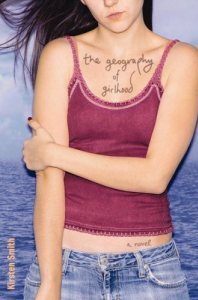
Little, Brown Books for Young Readers, February 2007.
Turns out, in YA literature, the “novel in verse” was becoming a viable genre in YA literature. He felt we could take a grouping of my poems that I’d written in college, pick the ones that could be focused on a coming of age experience, and turn them into a partial manuscript that suggested a narrative. Little Brown bought the partial manuscript, which gave me the perfect excuse to return to writing poetry. With 25 poems as the spine of the book, I needed to write about 100 more in order to make it into a fully realized novel.
Here’s a poem that was part of the original partial manuscript, written in 1999:
“Typical Bobby”
It was typical Bobby, typical me:
typical of him to call me into his garage,
typical of me to follow.
I was sixteen, hoping for a kiss
or a jar of his mom’s peaches.
Little did I know I’d be greeted
with a freshly skinned half-buck,
another one of Bobby’s prize marks.
Red and helpless, it swung there
as Bobby showed me around
the circumference of the body,
showed me the parts his mother
would make into a meal.
Never much of a braggart,
Bobby didn’t put the deer’s horns
on his roll-bar the way Stan Bondurant does.
And he hasn’t told many
about that night in the woods
when I scrambled into his camper
and ended up staying there,
giving him things he was used to hunting for
but never catching.
Be it in the slow dance or the forest,
Bobby likes to have flesh here and there.
He likes bringing me into his garage
and kissing me beside the kill.
Give him an animal without its skin,
or me without my underwear,
and you’d have typical Bobby:
his left hand resting on the flanks,
his right not pausing until
it was inside the body,
until it had found for certain
the meaning of tender.
Here’s a poem that I wrote in 2005 as part of the novel:
“Sleepless in Arizona”
Watching Bobby, I realize
the thing about a guy you’ve
spent your whole life loving from afar
is that even though he’s real
you’ve really made most of him up.
That’s probably why I hate Sleepless in Seattle.
My stepmom thinks it’s romantic
but what she doesn’t realize
is that Meg Ryan and Tom Hanks
have done so much fantasizing about each other
that if they were in the real world,
getting together would
definitely be a disappointment.
What if you were imagining Tom Cruise
and you got Tom Hanks?
Or what if you were imagining Tom Hanks
and you got Tom Arnold?
Say what you like, but here now,
looking across the room at the boy
I thought I so-called loved,
I am living proof that
a good imagination may be
the best friend of loners
but it is definitely
the enemy of lovers.
TRINKETS, the second YA novel I wrote over the course of 2007-2012 (!?!) is told in multiple perspectives about three shoplifting girls who bring out the worst-slash-best in each other, and it also contains poetry:
“Stolen Goods”
There’s a guy in the Hair Care section of Fred Meyer
who’s looking at me like he knows
what kind of person I am
but then I realize I’m being paranoid.
There’s no way he 0—or anyone, for that matter –
Could know I’m the kind of person who has three lip glosses
a Hello Kitty alarm clock
a packet of Red Vines
condoms (so I can see what they look like up close)
and a box of Crayola Markers
in my bag.
To top it all off,,
I slip a rhinestone barrette in there, too,
one that Rachelle might like.
Nothing helps new friendships like surprise trinkets.
Fortunately, Rachelle knows my parents have money
so she’ll never guess her gifts are stolen,
but if she were a thief herself
she’d understand that a stolen present
means way more than one that’s been bought
because of what you had to go through to get it.
The gift of these YA novels – even though it seems to take me awhile to write them — is to be able to stay connected to a young female audience and to my young female self, a girl who dreamed of being a poet, and would stop at nothing until she had her book of poetry published. True, she didn’t meet her goal of publishing a book at age 21, but even now, to have her words in print, feels like a victory unlike any other.

Kirsten Smith.
Kirsten Smith is a screenwriter of girl power movies such as LEGALLY BLONDE, 10 THINGS I HATE ABOUT YOU, SHE’S THE MAN, THE HOUSE BUNNY and THE UGLY TRUTH. She executive produced WHIP IT, starring Ellen Page, and directed two short films, both starring Anna Faris. She authored two novels, TRINKETS and GEOGRAPHY OF GIRLHOOD and has won multiple awards for her poetry. A native of Washington State, she now lives in Los Angeles with her dogs and her fiancée. She’s @kiwilovesyou on Twitter.





March 31, 2014
Are You Ready for April? Poetry Month, Camp Nano, Oulipost, and other Hijinks
So y’all know that around these parts April means a giant mess of celebration, chaos, and (hopefully) productivity in the name of poetry. This year, I’m buckling down and taking on at least one new challenge, and leaving the blog to guest posters (as per tradition) while I (hopefully) craft 30 poems in one of the craziest NaPoWriMo projects ever, which I will discuss further down the page.
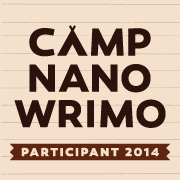
Camp NaNoWriMo.
April is also session one of Camp NaNoWriMo this year. Over the past few years I’ve come to love Camp NaNo. One of the coolest things about the camp sessions is that you can really customize it to your own needs. If you want to write a poetry collection, or a script, or (for reasons I can’t fathom) 100k instead of 50k, you can set your goal there. In my case, I usually bring the goal down to 40k and work with a partner (Hi, Priya Chand!) to write a project I usually wouldn’t tackle. This year I’m THINKING about writing a verse novel, but as of my writing this post, I haven’t decided yet. Hopefully I’ll get a brilliant idea around 3am and write it down and be ready to go. Normally, it would be tough to write a verse novel for NaNo, since verse novels are typically sparser wordcount-wise. But if I take this on, I’ll set the goal for 20k. And, hey, there’s a second session later this summer. I can write my verse novel then, unless Priya finally holds me to that promise that I’ll write a murder book with her. (Can I write a murder book in verse? Please?) Anyway, to those of you about to enter Camp NaNo, I salute you! Go, go NaNo!
[image error]
Oulipost forever!
The big, crazy challenge of this year is Oulipost. Every year Found Poetry Review does a super cool project for National Poetry Month. I participated in last year’s Pulitzer Remix, which was super fantastic. 85 poets “remixed” the text of books that had won the Pulitzer Prize in fiction. Using Jennifer Egan’s A VISIT FROM THE GOON SQUAD, I created 30 poems that later became my forthcoming chapbook A JAB OF DEEP URGENCY. This year, The folks at FPR have drawn on the Oulipo movement (which you can read more about here) to create 30 tricky writing prompts that 75 of us will be applying to our daily newspaper. In case you didn’t click that link, here’s the simplest explanation of Oulipo I can come up with: Oulipo started as a collective of French writers and mathematicians, and the word Oulipo is a shortened version of Ouvroir de littérature potentielle. Or, “workshop of potential literature.” So, the idea is that some of these poems could be super cool, and some might be a mess, but we’re here to create.
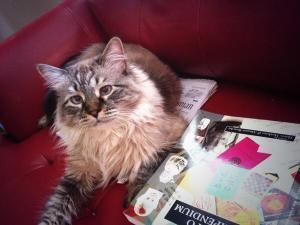
One newspaper, one OULIPO COMENDIUM, and one unhelpful cat.
So, for Oulipost, FPR is taking the already tricky Oulipo constraints (like a lipogram, which is created by omitting certain letters of the alphabet) and adding the additional challenge of applying these constraints to found poetry. We are only allowed to use text found in our newspaper, and, in some cases, in a particular article. It has to be the newspaper from the day the prompt is posted, too, so, you know, no working ahead. My stomach is in knots, but I think this will be a fantastic exercise. You can follow along with the project at the Found Poetry Review blog, where they will be posting prompts and info throughout the month. You can follow my progress at EKA OULIPOST, on tumblr. I’ll be using the Austin American-Statesman as my source text, but it will be super cool to see what these other poets — who are located all over the world! — come up with from their local papers.
I’m also off to TLA (the Texas Library Association annual conference) in San Antonio in April, and will be at the conference on the 9th and 10th. I have a signing on the 10th in the author area at 1pm, so if you’re at the conference, be sure to come say hi!
See? Super busy. And, yet, I think it will also be super fun. (If that verse novel happens, it will be a sweet, sweet miracle. Ha!) Enjoy your April, and good luck with YOUR projects. I’ll see you in May!





March 28, 2014
Review: TEEN SPIRIT by Francesca Lia Block
I’m starting to suspect that Francesca Lia Block can do no wrong. In her latest, TEEN SPIRIT, she again sets her story in Los Angeles, this time featuring the teen daughter of a recently unemployed screenwriter.
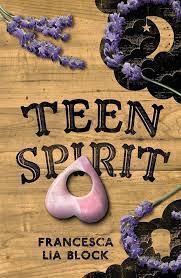
HarperTeen, February 2014.
Soon after the unexpected death of Julie’s grandmother, she and her mother are forced to move across town, where Julie starts at a new high school. Trying to put their lives back together isn’t easy. And Julie has never felt so isolated. Her mom starts dating some loser, and she doesn’t know who to talk to. Then Clark comes along. And Clark is the perfect BFF. He wears goofy hats. He loves Buffy the Vampire Slayer. He shares his weird lunch food. And he listens to Julie. Sure, he might have feelings for her, but Julie can pretend not to notice. Until an event with a Ouija board turns things upside down, and Clark’s irresistible brother comes into the picture. And then there’s the possibility that her house is now haunted.
With mystery after mystery to unravel, Julie ends up on a spiritual quest to expel the spirit who keeps rattling her fridge, to reconnect with her grandmother (and maybe even her mom), and to figure out what to do about the two boys in her life — boys she’s realized she can’t live without out. And, of course, the entire story is told with Block’s trademark lyricism and whimsy.
TEEN SPIRIT is another Francesca Lia Block book to add to your must-read list. And I hope I see it on lots of other awesome lists this year. I can’t wait to see what the marvelous FLB does next.





March 27, 2014
Review: TIN STAR by Cecil Castellucci
TIN STAR is everything that YA hard sci fi has been missing. And I didn’t realize it was missing until after I read this new title from Cecil Castellucci. TIN STAR has a colorful cast of characters, including lots of non-humanoid alien species. It takes place in a future with space colonies and both military and civilian ships roaming around the galaxy. And it has some seriously villainous villains. And with every page, you feel closer to the characters and farther away from home.
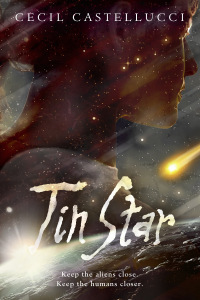
Roaring Brook Press, February 2014.
When Tula left Earth to help Brother Blue colonize a new planet, she thought she was joining a patriotic movement. She thought Brother Blue was paying extra attention to her because he likes her, and is maybe even grooming her for a leadership position. On the colony ship, Tula and her mother and sister are excited to reach their destination, to pioneer a new civilization, and to start a new life. Everything goes awry when, at a pitstop at a rundown space station, Tula notices Brother Blue might have made a mistake. She points it out to him, sure he’ll be grateful to her for saving the colonists on board. But instead, he beats her and leaves her for dead. Now, stranded, the only human on the station — the Yertina Feray — Tula must learn how to survive. With one reluctant ally, Heklek, Tula learns to navigate the new culture, resigned to the fact that she may never see her family again, but that no matter what happens, she will seek revenge on Brother Blue. What Tula doesn’t expect, however, is that she has another ally on board, someone watching her back behind the scenes. And Tula certainly doesn’t expect the three humans who board the Yertina Feray. Three humans who will change everything.
I don’t know that I’ve read such a beautifully-written hard sci fi novel since reading about Octavia Butler’s aliens in college. Her characters are complex, the alien species well-developed and their world well-planned. The language is concise while at the same time Lyrical. And, most importantly, this story is unforgettable. Cecil Castellucci is clearly a genius. I want more.









